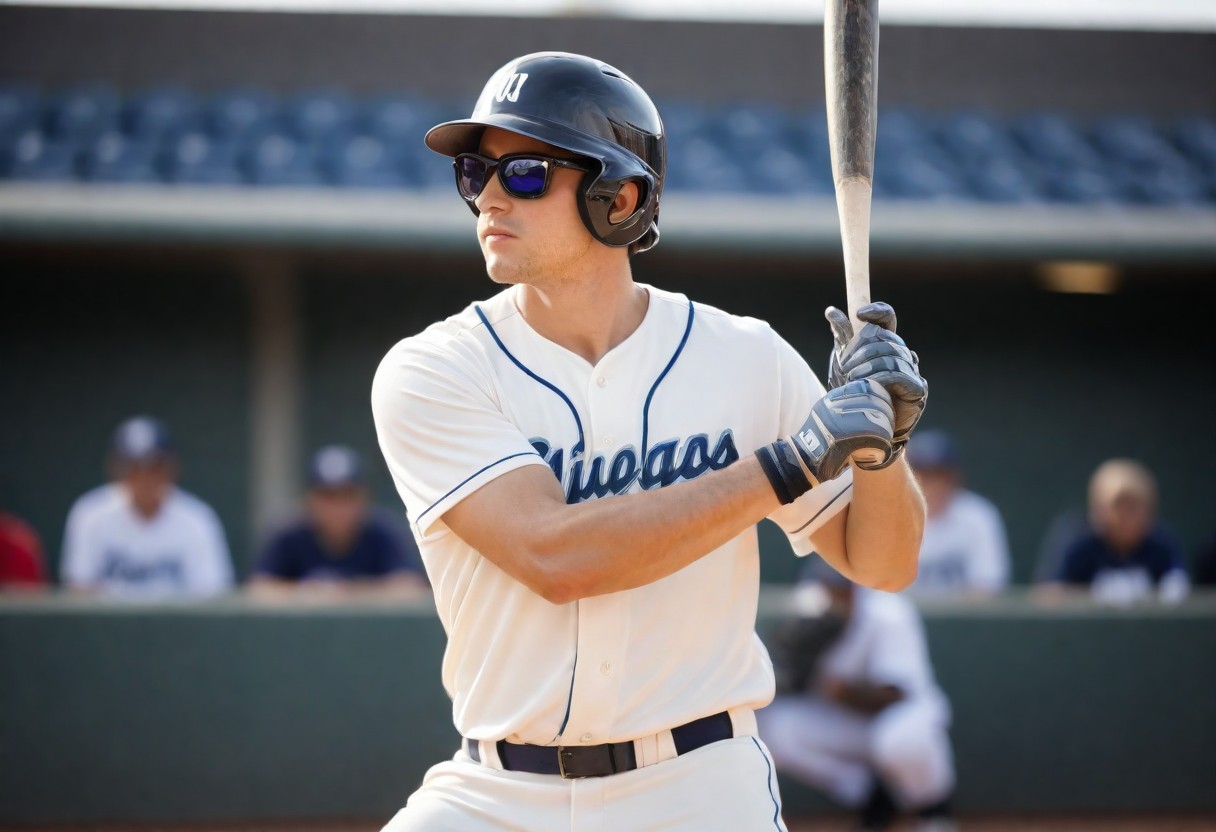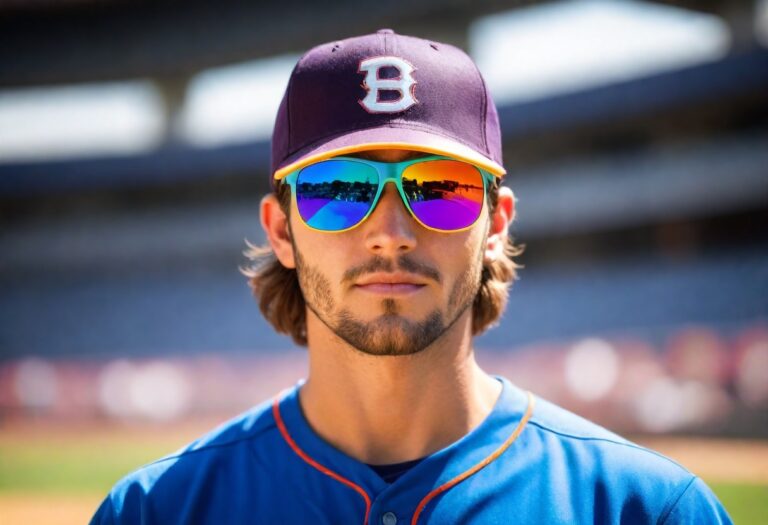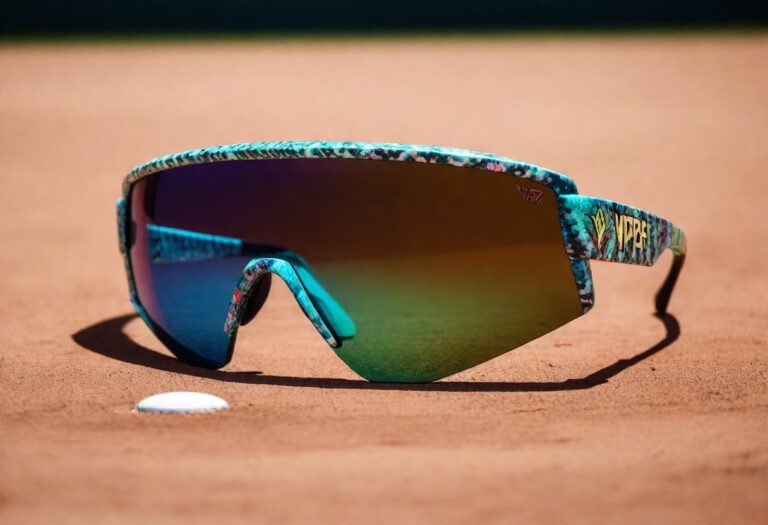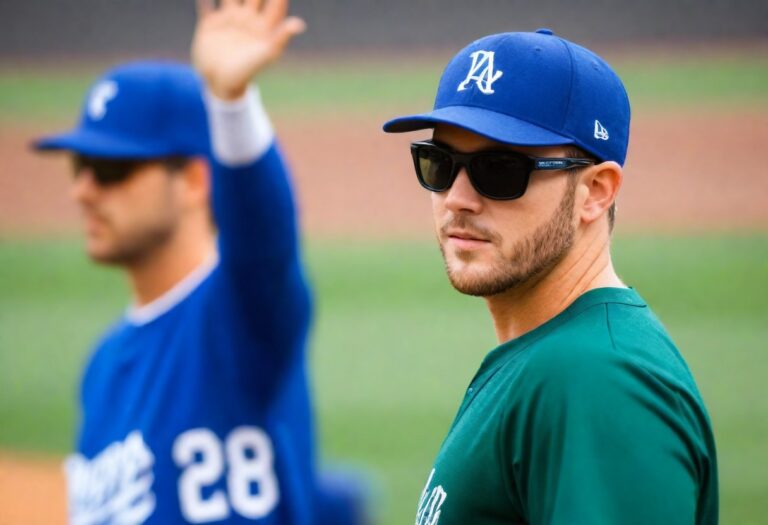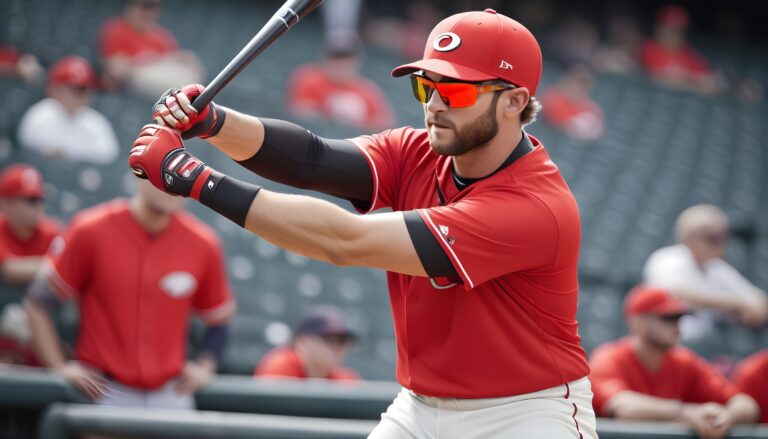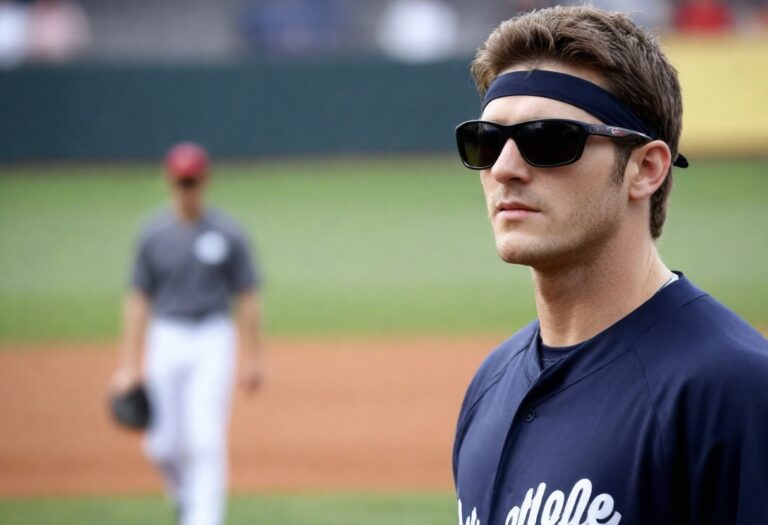Can You Wear Sunglasses While Batting
Can You Wear Sunglasses While Batting? The simple answer is yes, you can wear sunglasses while batting. Many professional baseball and softball players do so to protect their eyes from the sun’s glare and to enhance their vision of the ball.
However, it’s crucial to choose the right kind of sunglasses. Not all sunglasses are suitable for sports, especially for a high-intensity activity like batting.
In this article, we’ll explore the benefits of wearing sunglasses while batting, the types of sunglasses that are best suited for this sport, and some tips on how to choose the right pair for you. So, let’s get started!
Key Takeaways
- Wearing sunglasses while batting is allowed and can offer benefits such as glare reduction and improved visual acuity, enhancing player performance.
- Players must choose protective sunglasses that comply with league regulations, which vary across different levels of play, to avoid penalties.
- The selection of the right eyewear involves considering factors like fit, lens technology, and impact resistance to ensure safety and comfort.
- Sunglasses have become a part of baseball culture, serving as both a functional piece of equipment and a fashion statement for players.
- Expert recommendations and the experiences of professional players suggest that the right sunglasses can positively impact batting performance and safety.
The Safety Debate: Wearing Sunglasses at the Plate

Potential Risks and Benefits
The decision to wear sunglasses while batting is not just a matter of personal preference but also involves weighing potential risks against benefits.
Safety is the primary concern, as sunglasses can protect the eyes from harmful UV rays and reduce the risk of injury from dirt, debris, or an errant pitch.
However, there are considerations to be made regarding the type of sunglasses used, as improper fit or lens tint can potentially impair vision and reaction time.
Benefits of wearing sunglasses at the plate include:
- Enhanced visual clarity in bright conditions
- Protection from UV radiation
- Reduced eye strain and fatigue
On the other hand, potential risks involve:
- Distraction or discomfort if not accustomed to the eyewear
- Reduced visibility in varying light conditions
- Possibility of the glasses shattering upon impact
Ultimately, the choice to wear sunglasses while batting should be informed by a thorough understanding of these factors and personal comfort levels.
Understanding the Official Rules
The official rules of baseball, as outlined by various leagues, provide clear guidelines on equipment use, including eyewear.
Major League Baseball (MLB) has specific regulations that address the use of sunglasses by players.
For instance, MLB Rule 1.15 states that players are not allowed to wear items that could distract the umpire or opposing players.
This rule is particularly relevant to pitchers, as highlighted by John Daniel’s article, which points out that brightly colored accessories are prohibited.
In youth leagues, such as the 11U division, the rules can differ. The NBA-approved rules for the 11U Division specify standard baseball rules with certain adaptations for the age group.
These adaptations include specific game durations, playoff standings, and equipment regulations.
Players and coaches at all levels need to be familiar with these rules to ensure compliance and avoid penalties.
When selecting sunglasses for batting, players must consider not only the safety and performance aspects but also the compliance with official rules.
This ensures that the chosen eyewear enhances performance without risking rule violations.
Player Perspectives on Sunglass Use
Baseball players have varied opinions on wearing sunglasses while batting. Some players feel that sunglasses are essential for reducing glare and improving visibility, especially on sunny days.
Others are concerned that sunglasses might shift during a swing, potentially affecting their focus or the outcome of their at-bat.
When it comes to the types of sunglasses worn, preferences vary:
- Aviator-style sunglasses are favored by some for their lightweight feel.
- Sport-specific designs often feature semi-rimless frames, which provide an unobstructed view.
Ultimately, the decision to wear sunglasses at the plate is a personal one, influenced by a player’s comfort level and the conditions on the field.
Choosing the Right Eyewear for Baseball
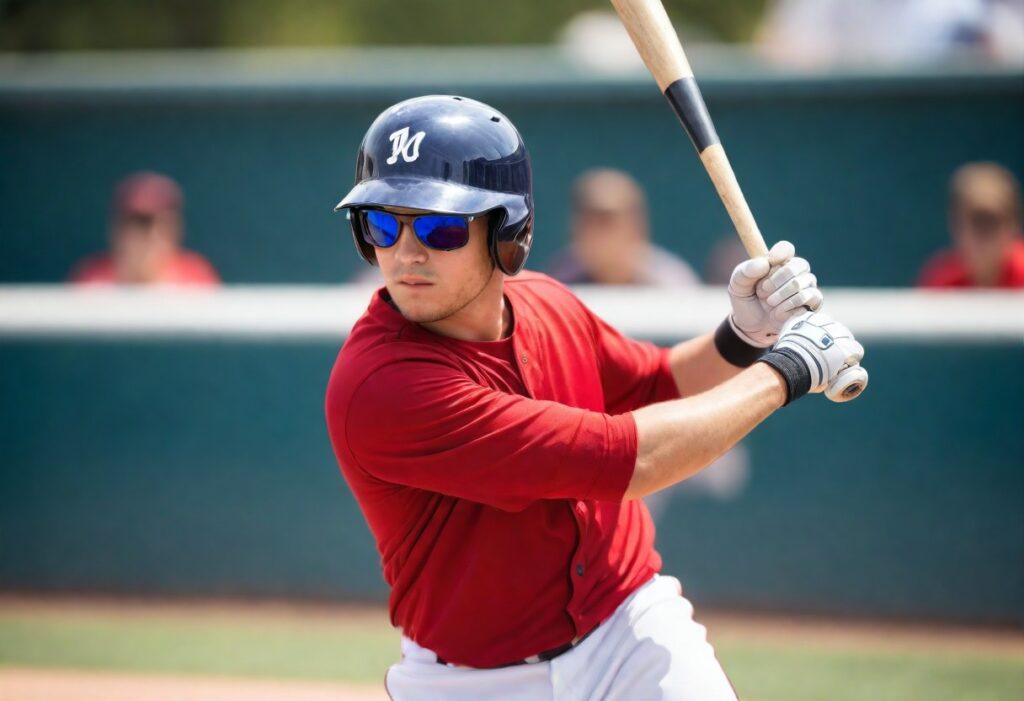
Types of Protective Sunglasses
When selecting the right sunglasses for baseball, players have a variety of options to choose from.
Wraparound frames are a popular choice as they offer a wider field of vision and ensure comprehensive UV protection.
These frames are designed to contour to the shape of the face, providing coverage that helps to shield the eyes from all angles.
Brands like Oakley, Costa, Ray-Ban, and Blenders offer specialized sunglasses that cater to the needs of baseball players.
These sunglasses often feature polarized lenses, which are essential for reducing glare and improving visual clarity on the field.
Additionally, many models come with impact-resistant lenses and frames, a crucial aspect of protecting players from potential injuries.
It’s important to consider the lens tint as well. Different tints can enhance contrast and depth perception, which are vital for tracking the ball effectively.
Amber or brown tints are known to be particularly beneficial in enhancing the visibility of the ball against the sky or the green of the field.
Factors to Consider When Selecting Sunglasses
When choosing sunglasses for baseball, several factors must be taken into account to ensure both safety and performance enhancement.
Lens quality is paramount; look for lenses that offer high levels of UV protection and are shatter-resistant to protect your eyes from both the sun and potential impact.
The tint of the lens is also crucial, as it affects the contrast and visibility of the ball. Amber or brown tints are often recommended for their ability to improve contrast against blue skies and green fields.
The frame design should provide a comfortable, secure fit that doesn’t slip during movement. Lightweight materials and a wraparound style can offer both comfort and an extended field of vision.
Additionally, consider the following points:
- Durability to withstand the rigors of the game
- Non-slip grips to keep the sunglasses in place
- Compatibility with helmets or caps
Lastly, personal preference in style should not be overlooked, as confidence and comfort can indirectly influence performance.
However, this should not come at the expense of the protective features and functionality of the eyewear.
Recommendations from Experts
When selecting sunglasses for baseball, experts emphasize the importance of choosing eyewear that provides both protection and performance enhancement.
Opt for sunglasses that offer 100% UV protection to safeguard your eyes from harmful rays.
Additionally, consider the following points:
- Lens tint should improve contrast and visibility, especially on sunny days.
- Frames must be lightweight and durable, with a secure fit to prevent slipping during play.
- Polarized lenses can reduce glare, but may not be suitable for all players due to potential difficulties in tracking the ball.
Consulting with a sports vision specialist can provide personalized recommendations based on individual needs.
Moreover, referencing reputable sources such as the ’10 Best Sunglasses of 2024′ list by Outdoor Gear Lab can guide players toward high-quality options that have been tested and rated by experts.
Impact on Performance: How Sunglasses Affect Batting
Visual Acuity and Glare Reduction
The ability to see the ball clearly and react quickly is crucial for a batter. High visual acuity is essential, not just for performance but also for safety.
Sunglasses designed for baseball can significantly reduce glare, which is especially beneficial during day games when the sun can be a major distraction.
- Reduction of glare helps batters track the pitch more accurately.
- Protection from UV rays is vital for eye health during long periods outdoors.
- Preventing foreign objects from reaching the eyes is an added safety measure.
Selecting the right sunglasses is a balance between enhancing visual clarity and ensuring eye protection.
Eye experts from institutions like the EXCEL Laser Vision Institute emphasize the importance of eyewear that addresses these needs for athletes.
The Psychology of Comfort and Confidence
The mental aspect of baseball is just as crucial as the physical, and the psychology of comfort and confidence at the plate can significantly influence a player’s performance.
Wearing sunglasses can provide a psychological edge, offering a sense of security and control in the batter’s box.
Factors contributing to this psychological comfort include:
- The reduction of glare, which can help batters track the ball better.
- The shielding of eyes from the sun and opposing players, creating a more focused environment.
- The association of sunglasses with professionalism and preparedness, boosting self-esteem.
Ultimately, the choice to wear sunglasses while batting is a personal one, but for many players, the comfort and confidence they provide can be a game-changer. It’s about finding the right balance between safety, visibility, and mental assurance.
Case Studies: Professional Players’ Experiences
The experiences of professional baseball players with sunglasses during batting reveal a mix of preferences and performance impacts.
Bryce Harper, a notable figure in baseball, is known for his selective use of eyewear at the plate. His choices often reflect a balance between comfort, visibility, and protection.
- Players like Harper may opt for sunglasses on particularly bright days to reduce glare and enhance focus.
- In contrast, some players find sunglasses to be a distraction or uncomfortable, potentially affecting their concentration and performance.
- The psychological aspect of wearing sunglasses can’t be overlooked; for some, it provides a sense of confidence and control.
These case studies underscore the importance of personal preference and the need for equipment that aligns with an individual player’s comfort and visual requirements.
Exploring the Rules: Compliance in Professional and Amateur Baseball
Uniform Regulations Across Different Leagues
Uniform regulations in baseball are crucial for maintaining the sport’s integrity and ensuring fair play.
Each league has its own set of rules that players must adhere to, which often includes specifications for uniforms and equipment.
For instance:
- In some leagues, players are required to wear matching uniforms, including gray pants, a team-colored shirt, and a matching hat.
- Protective gear is mandatory, with all batters and runners needing to wear helmets with fastened chinstraps or c-flaps, and catchers donning full protective equipment.
Compliance with these regulations is enforced strictly, with consequences ranging from warnings to ejection from the game for repeat offenses.
It’s essential for players and coaches to be familiar with the specific rules of their league, as they can vary significantly from one organization to another.
Consequences of Non-Compliance
Non-compliance with uniform regulations in baseball can lead to a range of consequences, depending on the severity of the infraction and the specific league’s policies.
Minor violations may result in warnings or bench restrictions, where a coach or manager is confined to the dugout for the remainder of the game.
More serious breaches, such as those involving safety equipment or malicious contact, could lead to ejections or forfeits.
In professional leagues like MLB, the repercussions can be even more significant. For instance, Rule 21 of MLB outlines strict penalties for gambling-related offenses, which can include lengthy suspensions or even a lifetime ban from the sport.
Players and team personnel must understand and adhere to these rules to avoid detrimental impacts on their careers and their teams.
How Rules Shape Player Choices
The intricate web of rules governing baseball can significantly influence player decisions, particularly regarding equipment use.
Uniform regulations, while aiming for standardization, can inadvertently steer players towards or away from certain gear choices.
For instance, restrictions on the color or branding of sunglasses may limit options for players who are also considering style and sponsorship deals.
Players must navigate these rules to avoid penalties, which can range from warnings to ejections, depending on the severity of the infraction.
The Bench Restriction Rule introduced by Baseball Ontario exemplifies a minor violation management tool, restricting a coach or manager to the bench for the remainder of the game for certain behaviors.
This rule, while not directly related to equipment, underscores the importance of compliance in all aspects of the game.
In summary, players often weigh the following when selecting gear:
- The potential for rule violations and associated penalties.
- The impact of equipment restrictions on personal preference and performance.
- The influence of league regulations on available equipment options.
The Role of Sunglasses in Baseball Culture
Fashion Statements and Personal Branding
In baseball, sunglasses have transcended their functional role to become a significant element of a player’s fashion statement and personal branding.
Athletes often select frames and lenses that reflect their personality, whether it’s a preference for classic aviators or the latest in high-tech, wraparound designs.
These choices often resonate with fans, who may adopt similar styles in a show of support.
The impact of sunglasses on personal branding can be seen in the variety of styles sported by players.
Some opt for understated, clear lenses, while others go bold with mirrored or tinted options.
The following list highlights the diversity in choices:
- Classic aviators for a timeless look
- High-tech wraparound frames for a modern edge
- Mirrored lenses for a statement of confidence
- Tinted lenses for a unique on-field identity
Moreover, the integration of sunglasses into a player’s image can lead to endorsement deals and collaborations with eyewear brands, further solidifying their status as fashion icons within the sport.
The choice of sunglasses is not merely a matter of personal preference; it significantly impacts a player’s performance on the baseball field, as well as their marketability off it.
Sunglasses in Baseball Memorabilia and Merchandising
The intersection of baseball and fashion often finds a unique expression in the world of memorabilia and merchandising.
Sunglasses have become a staple item, not just for players on the field, but also for fans and collectors.
The market for baseball-related sunglasses is diverse, offering everything from vintage-style frames commemorating historic games to modern designs endorsed by current stars.
- Collectible baseball cards often feature players donning their signature shades, adding a layer of personality to these cherished items.
- Merchandise stores and online platforms have seen a surge in sales of sunglasses designed with team logos and colors, turning them into fashionable accessories for game day.
- Autographed sunglasses by baseball legends can fetch high prices at auctions, reflecting their status as both sports equipment and fashion statements.
The trend extends beyond the physical products, with digital collectibles and virtual memorabilia incorporating sunglasses as a key visual element.
As the ‘The Amazon of Sports‘ expands its reach, the line between sports gear and lifestyle branding continues to blur, making sunglasses an integral part of baseball’s cultural impact.
Iconic Moments in Baseball with Sunglasses
Baseball has had its fair share of memorable moments where sunglasses played a starring role.
From shielding eyes from the glaring sun to becoming a part of a player’s signature look, sunglasses have etched their place in baseball history.
- One such iconic moment is when a player hits a home run and rounds the bases with their shades reflecting the stadium lights. It’s a powerful image that captures the essence of cool under pressure.
- Another unforgettable scene is the outfielder making a crucial catch, with sunglasses firmly in place, ensuring the sun doesn’t impede their vision.
- Off the field, sunglasses have become synonymous with the laid-back, confident style of baseball players, often seen during interviews or public appearances.
These instances not only highlight the functional aspect of sunglasses in the sport but also their contribution to the culture and image of baseball.
Conclusion
In conclusion, the question of whether it is safe to wear sunglasses while batting has been thoroughly examined.
The rules and regulations of the game allow for protective sunglasses to be worn by players, indicating that safety is a priority on the field.
Not only do sunglasses protect players from the sun’s glare, which can be a significant distraction and hazard, but they also offer physical protection for the eyes.
With the inclusion of sunglasses in the list of approved protective gear, alongside helmets and other equipment, it is clear that wearing sunglasses while batting is not only safe but also encouraged to maintain the well-being of players.
As we’ve seen, the game of baseball is as much about safety and preparation as it is about skill and sportsmanship.
So, whether you’re stepping up to the plate or cheering from the stands, remember that the right gear, including sunglasses, plays a crucial role in the enjoyment and safety of the sport.
Frequently Asked Questions
Is it safe for batters to wear sunglasses while at the plate?
Yes, batters are allowed to wear sunglasses while batting. It is considered safe and can help reduce glare and improve vision, provided the sunglasses are appropriate for sports use.
Are there any official rules regarding the use of sunglasses in baseball?
Official rules do not prohibit the use of sunglasses by players. Players are allowed to wear sunglasses, and there are no penalties such as automatic outs or being unable to play for wearing them.
Can sunglasses be a part of the uniform in professional and amateur baseball?
While uniform regulations vary across leagues, sunglasses are generally not considered a violation of uniform codes as long as they do not interfere with the game’s integrity or player safety.
What factors should be considered when selecting sunglasses for baseball?
When selecting sunglasses for baseball, consider factors such as UV protection, lens tint, frame durability, comfort, fit, and whether they are designed for sports performance.
Do coaches also require protection from the sun during games?
Yes, baseball coaches also need to protect themselves from the sun, which is why wearing caps is recommended for them on game days.
Are there any restrictions on the type of sunglasses that can be worn during a baseball game?
While there are no specific restrictions on the type of sunglasses, it is advised to use protective sunglasses designed for sports to ensure they do not shatter upon impact and offer adequate eye protection.

